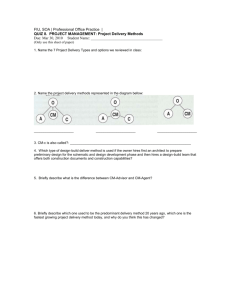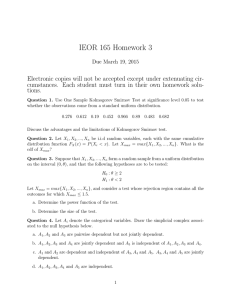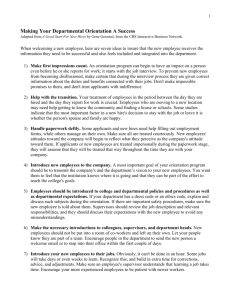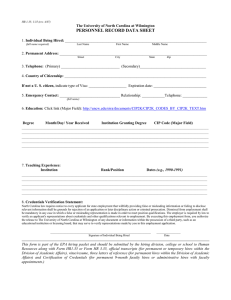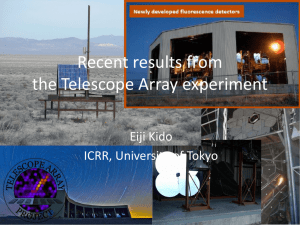Pierre Sokolsky
advertisement
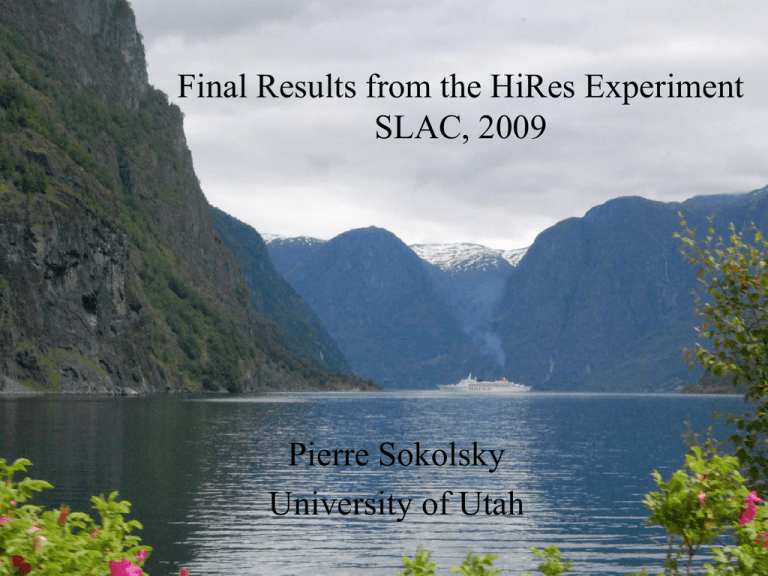
Final Results from the HiRes Experiment SLAC, 2009 Pierre Sokolsky University of Utah High Resolution Fly’s Eye Collaboration: S. BenZvi, J. Boyer, B. Connolly, C.B. Finley, B. Knapp, E.J. Mannel, A. O’Neill, M. Seman, S. Westerhoff Columbia University J.F.Amman, M.D.Cooper, C.M.Hoffman, M.H. Holzscheiter, C.A.Painter, J.S.Sarracino, G.Sinnis, T.N.Thompson, D.Tupa Los Alamos National Laboratory J. Belz, M. Kirn University of Montana J.A.J. Matthews, M. Roberts University of New Mexico D.R. Bergman, G. Hughes, D. Ivanov, S.R. Schnetzer, L. Scott, S. Stratton, G.B. Thomson, A. Zech Rutgers University N. Manago, M. Sasaki University of Tokyo R.U.Abbasi, T.Abu-Zayyad, G.Archbold, K.Belov, O.Brusova, S.A..Blake, Z.Cao, W.Deng, R.C.Gray, W.Hanlon, Y.Fedorova, P.Huentemeyer, B.F Jones, C.C.H.Jui, E.C.Loh, M.M.Maestas, K.Martens, J.N.Matthews, S.A.Moore, K.Reil, D.Rodriguez,,P.Shen, J.Smith, P.Sokolsky, R.W.Springer, B.T.Stokes, J.R.Thomas, S.B.Thomas, L.Wiencke University of Utah Reconstruction • The trajectory of the EAS can be determined in one of two ways: 1. 2. Monocular reconstruction using the arrival time of light signal at the detector. By intersecting the shower-detector planes (SDP) seen from the two detector sites. ti 1.) i t0 ti t0 RP tan i c 2 2.) Measured Shower Profile Measured shower parameters. Event by event: • Xmax in g/cm2; • Total energy of the primary particle: • Arrival direction Statistically: • Mass composition • p-air inelastic cross-section HiRes Spectrum • Monocular spectra - HiRes I and II • HiRes I - largest statistics, limited elevation angle viewing = high threshold energy • HiRes II - best low energy response • Stereo spectrum - best geometrical and energy resolution Monocular and Stereo Aperture Data/MC Comparison(mono) Stereo Geometrical Resolution Stereo Energy Resolution With Stereo Measurements, you have redundant measurements of Xmax and Energy HR2 Energy Resolution 15% Systematic 17% Mono versus Stereo Energy Measurements HiRes-1 mono vs. stereo The HiRes monocular energy is in excellent agreement with stereoscopic measurements ! 5σ Observation of the GZK Suppression (mono) • Broken Power Law Fits (independent data) – No Break Point c2/DOF = 162/39 – One BP c2/DOF = 63.0/37 • BP = 18.63 – Two BP’s c2/DOF = 35.1/35 • 1st BP = 18.65 +/- .05 • 2nd BP = 19.75 +/- .04 – BP with Extension • Expect 43.2 events • Observe 13 events • Poisson probability:P(15;51.1)= 7x10-8(5.3s) Mono and Stereo Spectra Mono – HR1 and HR2 Stereo Mono, stereo, AGASA HiRes/Auger spectra comparison Auger confirms all spectral features of HiRes spectrum Mono and Stereo Spectrum Consistent • Combined mono spectrum ~ 5 sigma evidence for GZK cutoff • Stereo spectrum ~ 4 sigma evidence for GZK cutoff • Ankle location and power law indices consistent for mono and stereo • Good agreement with Auger spectrum after 20% shift R. U. Abbasi et al. Astropart. Phys. (2009) to be published. Composition New Analysis – J. Belz • • • • • New stereo reconstruction – W. Hanlon Use Gaussian-in-age fits to find Xmax Compare to QGSJET01, 02 No Xmax reconstruction bias for p or FE Small Xmax detection bias now independent of energy above 10^18.2 eV. • Quantify Xmax width distribution as function of energy Can we understand the HiRes data with a very simple Ansatz? Pure protons and the QGSJet model? How is Xmax defined? • Generate CORSIKA showers in atmosphere – QGSJET01,02, Corsika etc. • Define Xmax numerically or by fitting • “spline” numerical fit - previously used • Gaisser-Hillas functional form - fit to simulation and data • Gaussian-in-age functional form • We now use Gaussian-in-age(GIA ) for both real and simulated showers Gauss-in-age fit Comparison of predicted elongation rates using different Xmax definitions Data and MC Cuts • • • • • Zenith angle < 70 deg Psuedo-distance to HiRes-2 > 10 km. Xmax bracketed in HiRes-2 FOV Energy > l0^18.2 eV Loose chi-sq profile fit and Xmax uncertainty cuts. Can we model poorly measured Xmax? Remove HiRes I bracketing requirement Overall comparison of Xmax and shower width data with QGSJET02 p and FE Reconstruction and Acceptance Bias after cuts QGSJET02 p and Fe Xmax plots, full detector simulation Data and elongation rate fits Elongation rate corrected for detector acceptance and comparison with previous results Xmax fluctuations data and p QGSJET02 Xmax resolution Comparison of data and p-QGSJET02,01 fluctuation widths Use 2-sigma truncated gaussian width to fit Xmax distr. Detector resolution is NOT deconvoluted! Conclusions_01 • A cut off has now been clearly observed by the HiRes mono and stereo data in the Northern hemisphere cosmic ray flux at the 5 sigma level. • An ankle structure is clearly seen in HiRes and in monocular TA data. • The composition is consistent with a light, mostly protonic flux. • The cut-off is consistent with the GZK prediction Anisotropy • No significant large scale anisotropies found by HiRes at any energy. • AGASA claim of clustering is not supported by HiRes data • However, one AGASA triplet becomes a quartet - significance still not strong. • Search for correlations with AGN’s and BL-Lacs HiRes AGN Correlation Study Take-home message: • Apply PAO cuts - no significant correlation • Split data in half and search for most significant cuts in z, theta, and Emin • Apply cuts to second half of data - no signigicant correlation • Use total data set using method proposed by Finley and Westerhoff (penalty for scanning over entire data set taken into account) - no significant correlation HiRes with PAO cuts • PAO has maximum significance for < 3.1 deg., Emin=.56 EeV, Zmax=.018 • 8 pairings from 13 events in confirming set. • Expect 2.7 chance pairings • PAO chance prob. = 0.0017 • HiRes with PAO cuts (10% shift) • 2 pairings from 13 events • Expect 3.2 chance pairings • HiRes chace prob. = .82 Independent HiRes search • First data set scan • Strongest correlation 1.7 deg., 15.8 EeV, zmax =0.02. (chance prob = 0.005) • Apply to second data set • 14 correlations out of 101 events • Chance probability .15 HiRes correlation with Veron AGN catalogue in North Black - AGN’s Blue - HiRes data Red - correlated events (from scan in z, theta and Emin) Sky Plots –data vs local LSS matter density model with HiRes aperture 6 degree smearing 40 EeV Claim exclusion at 95% for E> 40 EeV with θs < 10° (Koers, Tyniakov, Thomson) 57 EeV Conclusion_02 • No evidence of correlations with AGN’s in Northern Sky • No evidence of correlation with local LSS with smearing angles less than 10 degrees • Heavy nuclei? No clear evidence in HiRes data – consistent with protons • Large B fields? • Telescope Array now taking data to increase statistics Thank you! Procedure: set of MC events coming from LSS • Start with local LSS model. • Modify using HiRes aperture. • Simulate the data set; find average predicted event density. • Two parameters: 57 EeV – Minimum energy – Angular smearing to simulate magnetic fields • Expect ~1°, extragalactic fields, for E≥40 EeV1 • Expect 2°-4°, galactic fields. 40 EeV • Perform K-S test between data and expectation from LSS. • Repeat starting with an isotropic galaxy distribution. 1. T. Kashti and E. Waxman, JCAP 0805, 006 (2008). 10 EeV Smearing angle of 6° Results • Choose 95% c.l. exclusion to quote, a priori. • For isotropic model, get good agreement. • For local LSS model get poor agreement. • Exclude correlation at 95% c.l. for θs < 10°, E ≥ 40 EeV • At 57 EeV, Auger point, exclude correlation at 5° at 99.5% c.l. Data/MC Comparison - Stereo Excellent agreement between Simulation and observables Acceptance corrected data compared to input QGSJET p and Fe Stereo Spectrum Significance of GZK cutoff is 3.8 sigma in stereo Data. ↵Protons ↵Fe Comparison with PAO data, without and with acceptance correction Is the Width of the Xmax Consistent with protons? • Proton intrinsic shower fluctuations are larger than for heavy nuclei • Fe is superposition of sub-showers – intrinsic + detector resolution fluctuations in Xmax ~ 45 gm/cm2 • Proton showers intrinsic + detector resolution fluctuations ~ 70 gm/cm2 (Xmax-Xmax2/Xmax-av) – data vs MC Xmax Resolution
